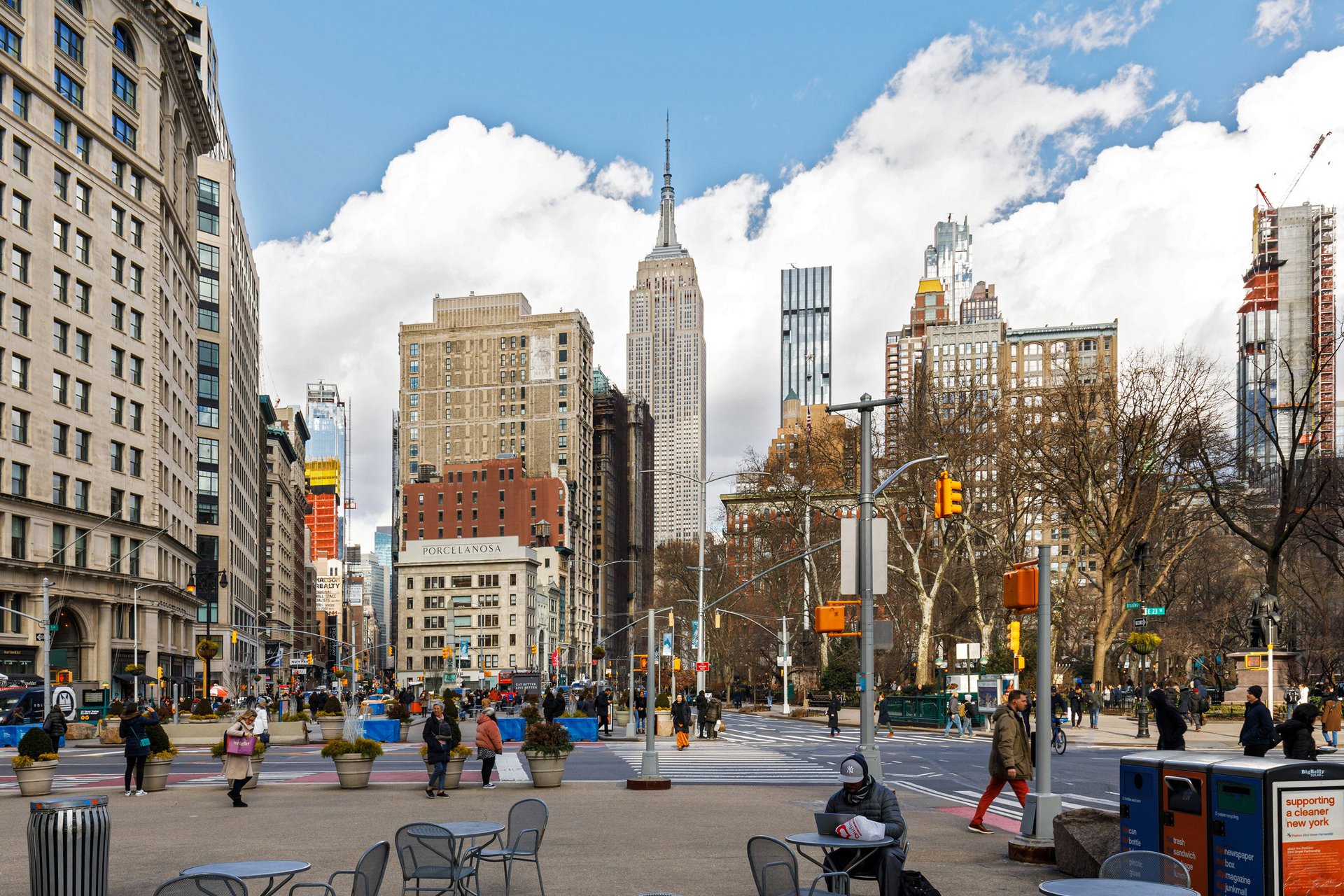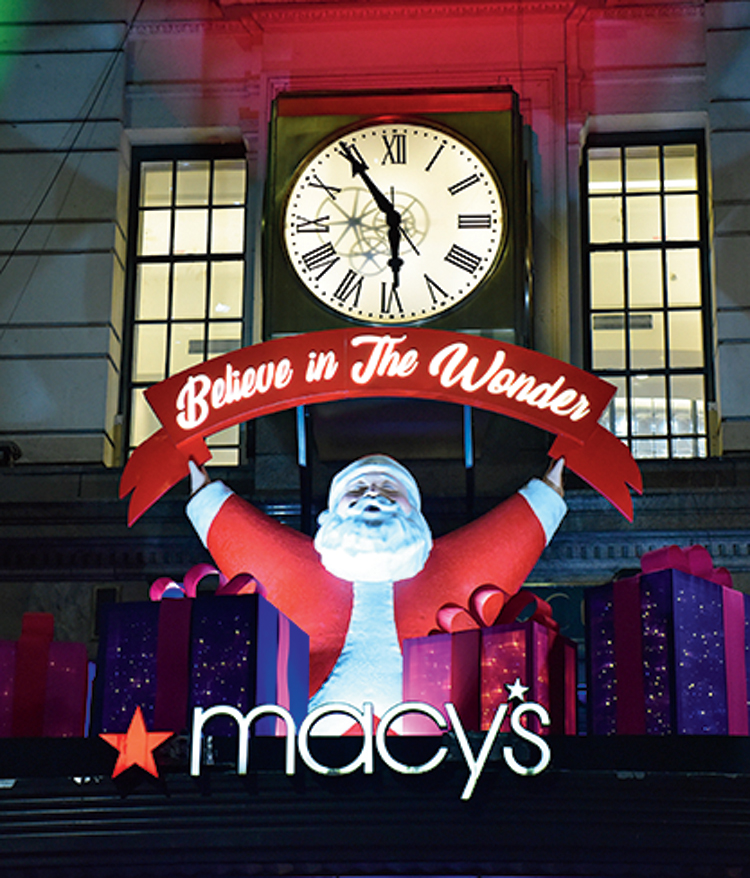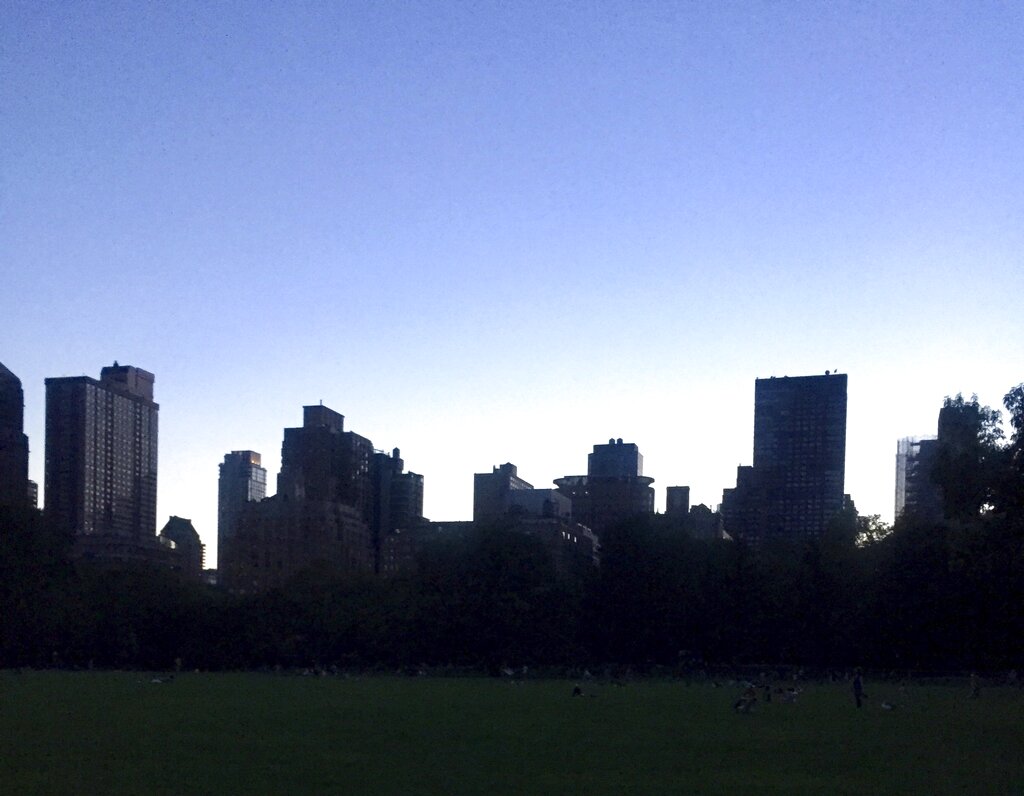Stand at the lot line on the east side of Fifth Avenue opposite the Empire State Building and look downtown, and you won’t be able to discern any world-famous landmarks.
But as you cross Fifth on 34th Street heading west, the distinctive prow of the Flatiron Building sails majestically into sight. And by the time you are standing at the base of the Empire State, you have a gorgeous unobstructed view downtown of the Flatiron, thanks to the 1902 landmark’s prominent location at the crossroads of Broadway and Fifth on 23rd Street.
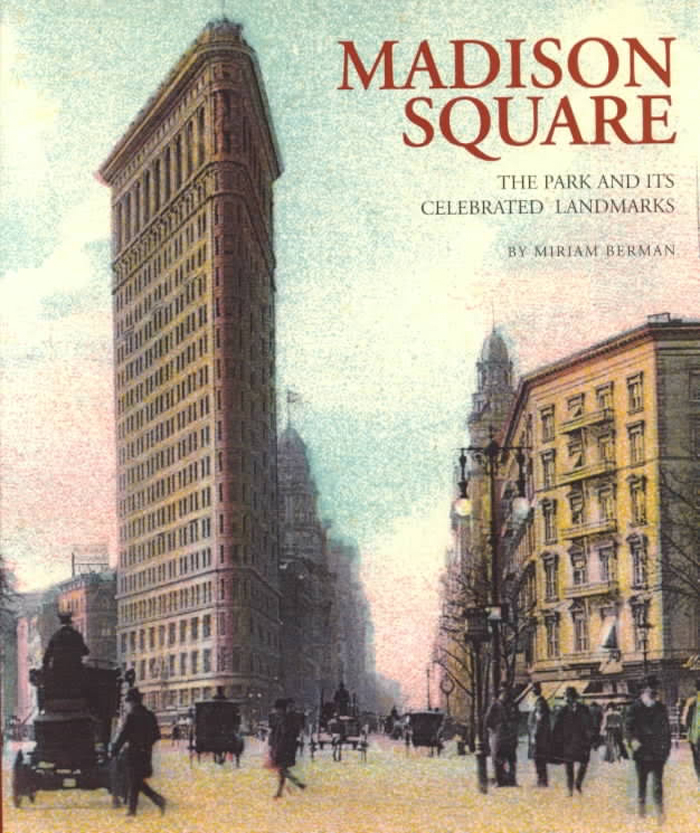
The cover of Miriam Berman's 'Madison Square: The Park and Its Celebrated Landmarks' Book cover
This is an urban magic trick that Miriam Berman, a preservationist and author of the book “Madison Square: The Park and Its Celebrated Landmarks,” likes to share with people she’s showing around.
Against all odds, as Berman has publicly observed — both as a professional tour guide and before the city landmarks commission — these two renowned city landmarks have enjoyed an unbroken visual dialogue up and down Fifth ever since the Empire State Building was completed in 1931. The view uptown from east of the Flatiron offers an equally clear vista of the Empire State Building in all its muscular, cloud-scraping glory.
“The preservation of a deserving sight line is just as important as the preservation of an iconic historic landmark,” Berman said.
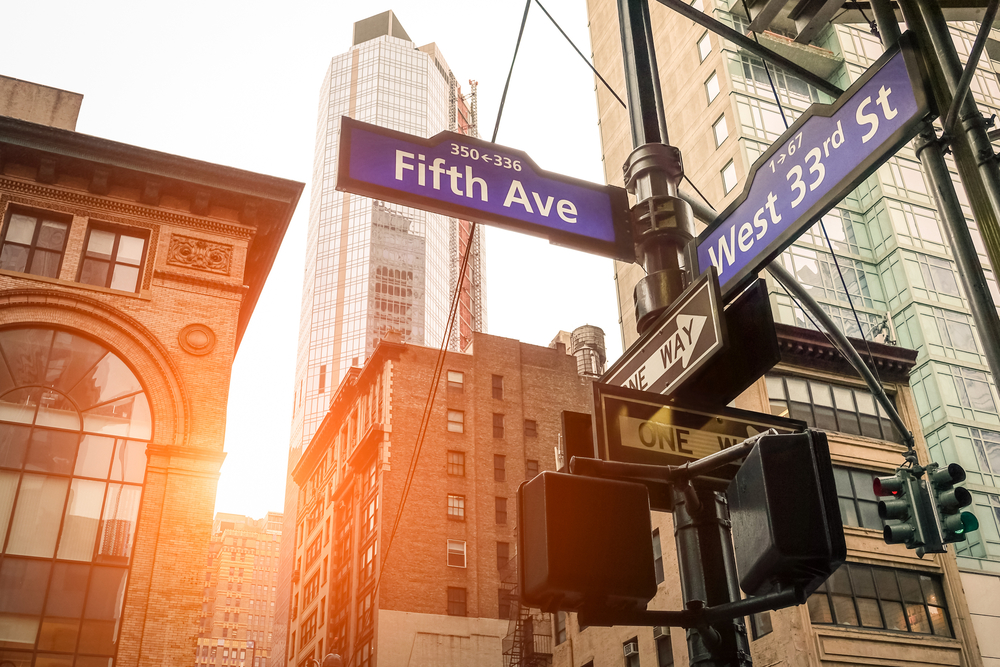
This 11-block stretch of Fifth Avenue, which preservationists have taken to calling the Iron-Empire Corridor, is under enormous development pressure, with at least eight towers recently built, under construction or planned on or near Fifth between 28th and 33rd streets Shutterstock
But New York City, that unsentimental master conjurer, is on the verge of performing the latest iteration of its own notorious magic trick: “Now you see it, now you don’t!”
This 11-block stretch of Fifth Avenue, which preservationists have taken to calling the Iron-Empire Corridor, is under enormous development pressure, with at least eight towers recently built, under construction or planned on or near Fifth between 28th and 33rd streets. Some of these high-rises, including a planned, city-approved 1,011-foot supertall at 29th Street and Fifth, threaten to block much of the singular view of the Empire State Building from around the Flatiron.
The remaking of Fifth Avenue in this corridor, and the attendant razing of venerable old buildings to make way for the new, recalls a similarly dramatic transformation of the area in the late 19th century.
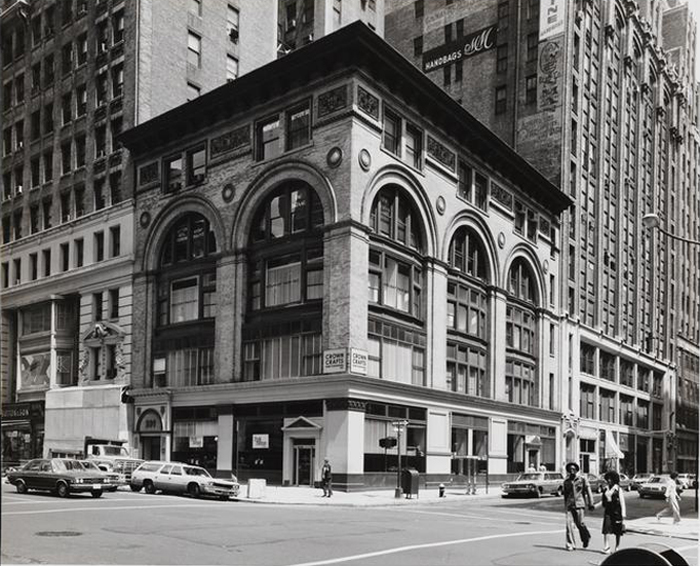
A.T. Demarest & Co. Building Pinterest/OzBibliophile
The neo-Renaissance A.T. Demarest & Co. Building, a luxe showroom for high-end carriages on the northeast corner of 33rd and Fifth, has been in the middle of both upheavals. In 1890, the five-story Demarest was erected rather cheekily right across Fifth from the long-standing residential center of capital-S Society in New York: two Astor family mansions, built in the 1850s, that stood on the site occupied today by the Empire State Building.
The demolition of three brownstone dwellings to make way for the Demarest, with its striking triple-height show windows clearly visible from the Astors’ parlors, was a telling moment amid the relentless march of trade into what had been an ultraexclusive stretch of Victorian mansions. Commercial buildings were anathema to New York’s elite, who in the 19th century were forever fleeing farther uptown to escape such noise and bother.
Today, however, it is the Demarest that seems on the verge of falling to the wrecking ball. Amid the howls of preservationists, the building’s owner, James Pi of JPK Associates, has applied to the city to raze the architecturally distinguished carriage showroom and construct a 26-story, mixed-use tower in its place.
The landmarks commission has repeatedly rebuffed the urgings of activists to protect the edifice, initiated in 2009, either by designating it as an individual landmark or by extending the Madison Square North Historic district beyond its northern border, which crosses Fifth, jigsaw fashion, around 29th Street.
Last month, the 29th Street Neighborhood Association, with the support of a coalition of preservation groups citywide, sent the commission a new report on the Demarest Building by architectural historian Anthony W. Robins. A rally was also held before Christmas, with scarf-swaddled preservationists singing, to the tune of “O Christmas Tree”: “O Demarest, O Demarest, how graceful are your arches!” Among the elected officials speaking in favor of landmark designation was Gale A. Brewer, Manhattan borough president.

Tiffany & Co. Shutterstock
Robins said in his report that the Demarest belonged to a select group of smaller, purpose-built retail buildings constructed in the late 19th or early 20th century for clients retaining top architects “to design a visible presence on the prestige avenue.” Survivors include the Gorham and Tiffany buildings at 390 and 397 Fifth, both designed by McKim, Mead & White; the Charles Scribner’s Sons Building at 597 Fifth, from plans by Ernest Flagg; and the Coty Building, at 714 Fifth, with decorative windows by René Lalique.
The Demarest is the oldest of this group, and the only one not protected by landmark status, although the Gorham and Coty buildings, like the Demarest, have been altered from their original designs.
“It’s one of a kind, and it’s the sole survivor of its type on this stretch of Fifth Avenue,” Robins said of the Demarest in an interview, making special note of its elegantly arched, three-story expanse of glass on both faces. “Those windows are extraordinary, and even though they’ve lost their sash, somebody could put that back.”
The landmarks commission, however, has deemed the changes disqualifying, a determination that preservationists said could encourage owners of other historic buildings to deface them preemptively to avoid becoming subject to landmark regulations.

Madison Square Garden Shutterstock
Zodet Negrón, an agency spokeswoman, said in an email that the commission’s staff had concluded that the Demarest lacked the “significance and integrity” of a landmark “due to the cumulative effect of its substantial alterations.” These changes, she said, included major renovations at the ground floor, replacement of the cornice, “the removal of the three-story-high decorative and structural infill from within all five monumental arched openings” and the enlargement of the attic-story windows.
The year 1890, when the Demarest Company opened its round-arched doors at 33rd Street, was a time of signal developments for the neighborhood between Madison Square and the vicinity of the Astor town houses. In November, spectacular fireworks showered the 341-foot tower of the recently opened Madison Square Garden, built to the magisterial designs of Stanford White at 26th Street and Madison Avenue. The garden provided a colossal new palace of diversions for an area that had already been changing from a tony residential neighborhood into a leisure and hospitality district.
At the A.T. Stewart mansion, across 34th Street from the brownstone of William and Caroline Astor, an event unfolded that sounded the death knell for the area as a residential enclave. The ostentatious marble behemoth, which Stewart, a multimillionaire department store pioneer, had built in the 1860s, was described by The New York Times as “perhaps the most palatial private residence of the Continent.” But in 1890, after the death of Stewart’s widow, the mansion’s furniture was auctioned off for “perhaps 10 cents on the dollar” because it was deemed old-fashioned, according to “Mrs. Astor’s New York,” by Eric Homberger. By that time the mansion was already being leased to the Manhattan Club.

The mansard-roofed, brick-and-brownstone Wilbraham, so-called bachelor flats built on the site of two demolished brownstones Wikipedia
Also in 1890, two Gilded Age Fifth Avenue hotels rose across West 30th Street from each other: the mansard-roofed, brick-and-brownstone Wilbraham, so-called bachelor flats built on the site of two demolished brownstones, and the dignified, neo-Renaissance Holland House. (Both buildings survive today, providing texture to the historic fabric of the corridor. The Wilbraham is a designated individual landmark; Holland House, used today as an office building, remains unprotected.)
In short order, the Astors themselves began tearing down their homes in favor of hotels. In 1893, William Waldorf Astor opened the Waldorf Hotel across from the Demarest Building on 33rd Street. Four years later, John Jacob Astor, Caroline’s son, built the Astoria Hotel next door, conjoining it with his cousin’s hostelry to form the Waldorf Astoria.
“With the passing of the old Astor Residences, the greatest social center New York had ever known ended,” Henry Collins Brown, director of the Museum of the City of New York, wrote in 1924, “and in its place was to arise an Avenue of Commerce, unique in the annals of the world.”
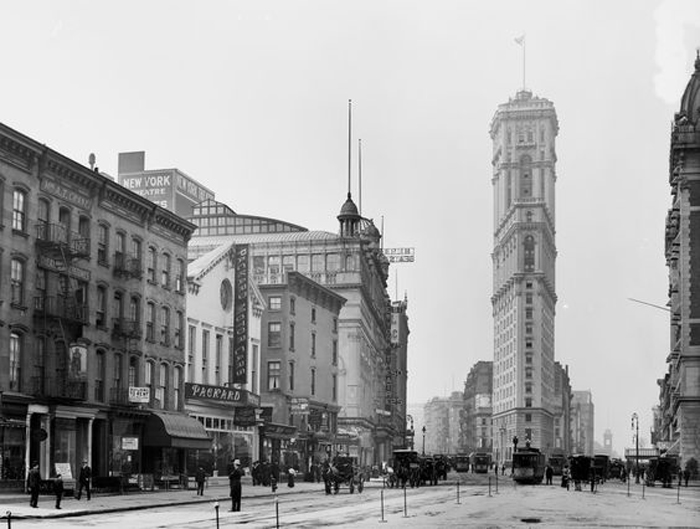
The hub of the horse-and-carriage industry was uptown at Longacre Square, the future Times Square, then known for its wagon factories and harness stores Pinterest/nycpast.tumblr.com
If the opening of the celebrated Waldorf Astoria brought the carriage trade right to the Demarest’s door, the location of the coach showroom and warehouse was strategically savvy for another reason. The hub of the horse-and-carriage industry was uptown at Longacre Square, the future Times Square, then known for its wagon factories and harness stores. By setting up shop instead on Fifth Avenue near Madison Square, the Demarest Company positioned itself in a neighborhood associated with the fashionable horsy set.
The central purpose of White’s Madison Square Garden was to provide a setting for the Horse Show of the elite Equestrian Society, an event that “annually stirred Fifth Avenue to almost carnival pitch,” according to Brown. During that week, “window displays along the Avenue were resplendent with the official blue and yellow colors” of the horse show association, while “stirrups, crops, whips, and other equine paraphernalia were much in evidence decoratively.”
In addition, the exclusive Coaching Club was located at 319 Fifth, just a block down from the Demarest. And the Brunswick Hotel, at 26th and Fifth, was considered the headquarters of society’s horsy element. The spring coaching parade traditionally began there, with four-in-hands and tandems causing a stir as they proceeded up Fifth, the horsemen sporting natty, brass-buttoned suits of forest green while guards sounded coach horns from the rear seats.

In 2015, the 10-story Bancroft Building, at 3 W. 29th St., was demolished over community objections YouTube/tokyocheesesteak
A great many 19th- and early 20th-century buildings survive in the corridor, but their ranks have been thinning in the unprotected stretch above 28th Street, north of the historic district.
The 1903 Kaskel & Kaskel Building, a marble Beaux-Arts pile built at 32nd Street for a high-end haberdashery, was destroyed in 2017, along with a 1905 Beaux-Arts neighbor, despite a preservation petition that garnered 20,000 signatures. To replace the pair, Cottonwood Management filed an application for a 539-foot-tall, mostly residential tower at 316 Fifth designed by Kohn Pedersen Fox.
In 2015, the 10-story Bancroft Building, at 3 W. 29th St., was demolished over community objections. A smart red-and-white-brick 1896 office building, the structure was topped with twin rooftop spires that nodded respectfully at those of the 1854 Marble Collegiate Church next door. Plans filed by the site’s new owner, HFZ Capital Group, call for a 551-foot-tall office tower containing 494,783 square feet, designed by Bjarke Ingels. HFZ’s website, however, envisions a building “of more than 600,000 square feet” on the parcel, which extends from 29th to 30th streets.
Also on 30th, 277 Fifth Ave., a new vertically striped tower designed by Rafael Viñoly, has reached its full height of 663 feet; it is being marketed as “the tallest residential condominium on Fifth Avenue.” An even taller condo, an 800-foot-high tower called Madison House, is climbing into the sky at 15 East 30th.
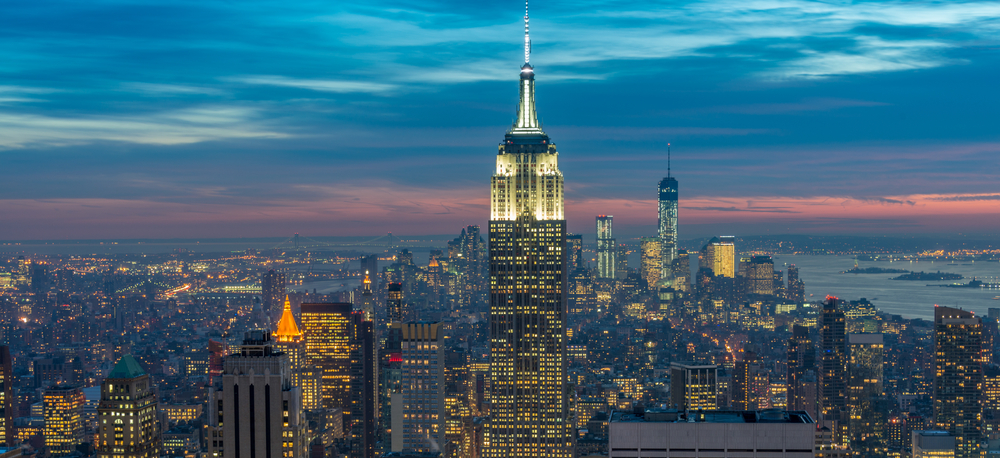
The Empire State Building against a Manhattan skyline Shutterstock
By far the loftiest among the Iron-Empire Corridor’s forest of new skyscrapers will be 262 Fifth, a slender, mixed-use supertall that will soar 1,011 feet over the NoMad neighborhood at 29th Street. Designed by Moscow-based Meganom for Five Points Development Group, the tower will have an aluminum-and-glass eastern facade.
Berman, the tour guide and author of the book “Madison Square,” lamented the effect that this supertall and other new towers would have on views of the Empire State Building from the south.
“The people who buy these apartments will probably see them twice a year when they come into town, and they’re taking the view away from all the people who come and look up all year long,” she said. “Part of the soul of the city is going to be lost.”
The creators of 262 Fifth, however, maintain that their project was built some 240 feet shorter than the Empire State Building’s roof out of respect for the landmark skyscraper.
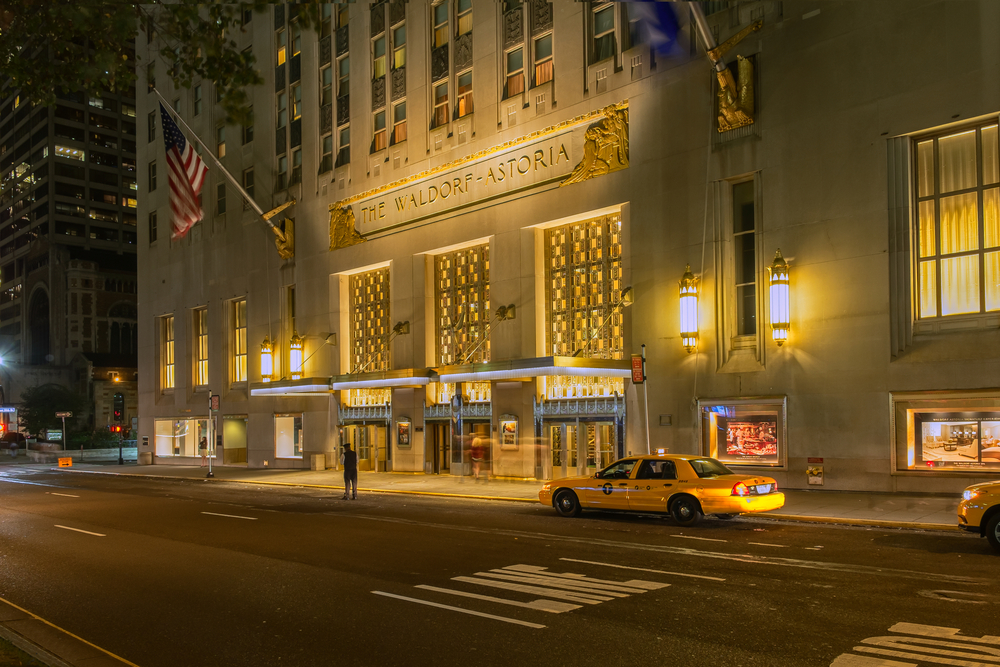
The Waldorf Astoria Shutterstock
“While our building, like other new towers currently planned and under construction in the neighborhood, will impact some view corridors, we are sensitive to our neighbors and have purposefully scaled back our building plans to maintain significant views of the Empire State Building and its pinnacle,” Yuri Grigoryan, 262 Fifth’s design architect, said in an email. “We have spent years refining our plans to create architecture that honors New York City’s proud history of skyscraper construction and contributes to the world’s most famous skyline.”
Given that the Empire State itself replaced, in 1931, the revered Waldorf Astoria, designed by acclaimed architect Henry J. Hardenbergh, there is perhaps a certain live-by-the-sword, die-by-the-sword poetic justice to the great Art Deco skyscraper’s finding itself hemmed in by competing high-rises.
“This is New York City,” said Robins, the architectural historian. “We do two things really well: Build ever taller buildings and complain about them.”

